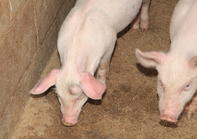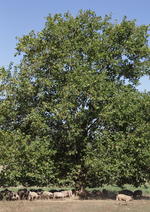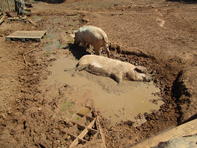A healthy pig has a clean, soft skin with a distinct bloom. According to the Pork Producers Production Organisation’s Pigs for Profit manual.

Something is wrong if the skin becomes red or purple, is broken, wounded, bleeding, oozing pus, scruffy, crusted, scabby, pigs have bald patches, there are visible parasites and pigs are constantly rubbing themselves against objects to relieve itching. A few of the many conditions that may affect the skin of pigs, are highlighted here.
Wounds, broken skin, puss and flies settling on a small area on the pig may be due to fighting, bites or injuries by sharp objects, such as nails, wires or the edges of sharp metal sheets.
Injury

Treatment Wounds should be cleaned with a disinfectant and treated with a wound spray, such as iodine or gentian violet. Farmers should avoid overcrowding pigs, as this will lead to fighting. Pens and sties should be regularly checked to identify and remove, safeguard or fix things that may cause injuries.
Sunburn

White skinned pigs are particularly sensitive to sunburn, which will manifest in painful red flushing of the skin and sometimes also blisters. Sunburn may lead to pigs becoming ill from heat stroke, with possible symptoms including distress, a high respiratory rate, muscle trembling, red skin, weakness, vomiting, diarrhoea, dehydration and a fever.
Pigs can die from heat stroke if not treated in time. According to an article of the National Animal Disease Information Service (NADIS), Pig Health – Sunburn and heat stroke/heat stress, sunburn can be confused with other outdoor situations that may cause the reddening of the skin and skin blisters, such as enhanced sensitivity to sunlight caused by certain plant toxins, in for example parsnips, carrots, parsley, rape and oats.

Treatment To prevent sunburn and heat stroke, each pig in a herd should have access to enough shade and cool clean drinking water. A mud wallow, for pigs that are kept outside, may provide partial protection against sunburn if the whole body of the pig is covered in thick mud.
NADIS suggests the use of a rescue cream or emollient to ease discomfort and aid healing in severely sunburnt pigs and the use of non-steriodal anti-inflammatory painkillers in more severe cases.
The Pig Site in its Quick Disease Guide, suggests that farmers treat pigs for heat stroke by immersing the animals into cold water or a spray and or dribbling cold water into the rectum of the animal using a flutter valve.
By Glenneis Kriel